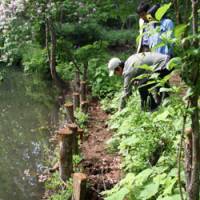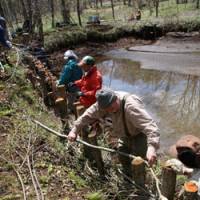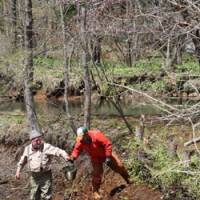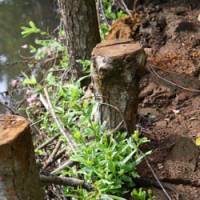About 20 years ago I had a large pond dug in our Afan woods up here in the Nagano Prefecture hills. It was in a place that was always waterlogged when the snow melted, and in spring there were lots of puddles that became home to thousands of tadpoles. But then, as the weather warmed up, the puddles would dry out and the tadpoles would die.
Even so, the ground beneath was perpetually soggy with stagnant water, and trees growing there would reach a certain age and then die off as their roots were drowned.
That's why I decided to dig a large pond there. The ground was too heavy to do the job by hand, so I hired a mechanical backhoe and an operator. In order not to damage the forest floor too much, we laid a temporary road of logs to run the heavy tracked vehicle in.
The pond is about the size of a large swimming pool, more than two meters deep in parts, and it has a little island for ducks to nest on. During the excavation, we found that until about two meters down we were taking out fine red dirt, but after that there was a bed of rounded boulders and gravel. Probably, long ago, a stream had run through there, and the red silt we found covering the old river bed had surely washed down from the mountain in times when the forest had been cleared.
At that depth, too, we found a flow of clear, icy-cold water — and there in among the boulders and gravel we found shards of pottery with a wavy-comb pattern.
I reported my find and presented the shards to the local Board of Education, and they identified the pottery as dating from early in the Yayoi Period (300 B.C. to A.D. 300). An expert came around to inspect the site and decided that because it was not a major find, and as it could easily be drained should there be a later need for research, we could go ahead with creating our pond — which I named Yayoi Ike.
The land around the pond drained well enough for trees to grow, and at the time we planted a row of mountain cherries. Other species seeded themselves. The pond quickly attracted frogs and aquatic insects, and it was no doubt visiting ducks that brought in the eggs of small crucian carp stuck to their feet. A friend, uninvited, also put in some larger carp, and all the fish flourished.
The big carp proved to be absolutely delicious, but they also gobbled at the banks and muddied the water as they foraged for food in the mud on the bottom. So, every few years we drained the pond to harvest the fish — but some always escaped in the ooze. Finally, the pond got so muddy that last autumn we drained it altogether and left it over winter to make sure none of the larger carp survived.
This spring we removed as much of the mud from the bottom as we could by hand and repaired the parts of the bank that had been severely eroded and damaged by the carp.
I decided to borrow a technique I had seen in use on the banks of the River Thames when they were removing ugly, sterile concrete banks to improve the habitat for wildlife and fish.
We pollarded a couple of willows and alders growing on the bank by cutting them a little way up the trunks so they could sprout new shoots, then sharpened the offcut trunks into pilings which we drove into the bottom of the pond around the sides. Next we took willow and alder branches and wove them between the pilings to make a sturdy fence. We then filled the space between the eroded bank and the fence with more mud.
If wood is submerged in water, it takes a very long time to decay, and we count on the willow branches, and maybe the alders too, to sprout new shoots and roots, further strengthening the bank and providing natural access from pond to air when the dragonfly nymphs emerge.
This pond mud, what with all the dead leaves, carp feces and other detritus, was surely rich in nutrients, and I wondered if it would make fertilizer for my vegetable plots.
I have a wonderful book written in 1911 by an American agronomist named F.H. King. It has 248 photographic illustrations, and was reprinted by Dover Publications of Mineola, New York. Titled "Farmers of Forty Centuries," the book covers organic farming in China, Korea and Japan, and is in part based on the author's extensive travels in those countries in the first decade of the 20th century.
Professor King clearly did some marvelous research, and his book details the use of mud — especially canal mud — as a fertilizer in China.
I have been told by older folk that here in Japan, too, mud from natural ponds and from warm-water rice paddies was also used on fields.
I therefore decided to try it, and filled five 70-liter bins with mud that I put into shallow trenches on my vegetable plot, mixing it in with compost.
However, I may have jumped the gun a bit, because the mud was in a state of anaerobic decomposition — meaning it hardly had any oxygen in it — and really needed time to dry out in the air before being put into the field. Oxygen is important for the culture of healthy soil organisms, so burying the mud with compost while it was still wet might now mean it will take time before any nutrients in the mud can be released and used by the plants. I also worry about toxic sulphides and nasty anaerobic bacteria such as Clostridia.
Not that there is any point in worrying now; the stuff is in the ground and the cucumbers, tomatoes, peppers and runner beans are planted. I'll just have to keep my fingers crossed and see how they grow compared with plants in the rest of the field, which has just been composted — but with no mud.
On the other hand, if the mud works, then we'll have a constant supply of it, because ponds and slowly moving water courses constantly silt up. Before the canals and other waterways got polluted with heavy metals, toxic pesticides and all manner of modern obnoxiousness, those long-ago Chinese farmers were doing a double good deed by removing and using mud; one good deed for their land, and another to keep the canals clear.
Old Prof. King had nothing but praise for oriental farmers, who had organic farming down to a very exact and fruitful science and wasted nothing that could be used to improve the soil.
And our pond? Oh, the water is now clear, and the frogs and dragonflies have returned in numbers. Ducks and herons are visiting again as well.























With your current subscription plan you can comment on stories. However, before writing your first comment, please create a display name in the Profile section of your subscriber account page.